Achieving Highly Efficient Atmospheric CO2 Uptake by Artificial Upwelling
Abstract
:1. Introduction
2. Methods
2.1. Carbonate Chemistry Calculation
2.2. Power Balance Calculation
2.3. Efficiency Calculation
3. Results
3.1. The Effect of the Source DOW Depth and Plume Trapping Depth
3.2. Regional Effects
3.3. Seasonal Effects
4. Discussion
5. Conclusions
Acknowledgments
Author Contributions
Conflicts of Interest
References
- Lovelock, J.E.; Rapley, C.G. Ocean pipes could help the Earth to cure itself. Nature 2007, 449, 403. [Google Scholar] [CrossRef] [PubMed]
- Williamson, P.; Turley, C. Ocean acidification in a geoengineering context. Philos. Trans. A Math. Phys. Eng. Sci. 2012, 370, 4317–4342. [Google Scholar] [CrossRef] [PubMed]
- Handå, A.; McClimans, T.A.; Reitan, K.I.; Knutsen, Ø.; Tangen, K.; Olsen, Y. Artificial upwelling to stimulate growth of non-toxic algae in a habitat for mussel farming. Aquac. Res. 2013, 45, 1798–1809. [Google Scholar] [CrossRef]
- Ianson, D.; Allen, S.E. A two-dimensional nitrogen and carbon flux model in a coastal upwelling region. Glob. Biogeochem. Cycles 2002, 16. [Google Scholar] [CrossRef]
- Chung, C.-C.; Gong, G.-C.; Hung, C.-C. Effect of Typhoon Morakot on microphytoplankton population dynamics in the subtropical Northwest Pacific. Mar. Ecol. Prog. Ser. 2012, 448, 39–49. [Google Scholar] [CrossRef]
- Jiang, Z.-P.; Huang, J.-C.; Dai, M.; Ji Kao, S.; Hydes, D.J.; Chou, W.-C.; Jan, S. Short-term dynamics of oxygen and carbon in productive nearshore shallow seawater systems off Taiwan: Observations and modeling. Limnol. Oceanogr. 2011, 56, 1832–1849. [Google Scholar] [CrossRef]
- Oschlies, A.; Pahlow, M.; Yool, A.; Matear, R. Climate engineering by artificial ocean upwelling: Channelling the sorcerer’s apprentice. Geophys. Res. Lett. 2010, 37, 1–5. [Google Scholar] [CrossRef]
- Yool, A.; Shepherd, J.G.; Bryden, H.L.; Oschlies, A. Low efficiency of nutrient translocation for enhancing oceanic uptake of carbon dioxide. J. Geophys. Res. 2009, 114. [Google Scholar] [CrossRef] [Green Version]
- Keller, D.P.; Feng, E.Y.; Oschlies, A. Potential climate engineering effectiveness and side effects during a high carbon dioxide-emission scenario. Nat. Commun. 2014, 5, 3304–3315. [Google Scholar] [CrossRef] [PubMed] [Green Version]
- Le Quere, C.; Andrew, R.M.; Canadell, J.G.; Sitch, S.; Korsbakken, J.I.; Peters, G.P.; Manning, A.C.; Boden, T.A.; Tans, T.T.; Houghton, T.A.; et al. Global carbon budget 2016. Earth Syst. Sci. Data 2016, 8, 605–649. [Google Scholar] [CrossRef]
- Liu, K.-K.; Atkinson, L.; Chen, C.T.A.; Gao, S.; Hall, J.; MacDonald, R.W.; McManus, L.T.; Quiñones, R. Exploring continental margin carbon fluxes on a global scale. Eos Trans. Am. Geophys. Union 2000, 81, 641–644. [Google Scholar] [CrossRef]
- Painting, S.J.; Lucas, M.I.; Peterson, W.T.; Brown, P.C.; Hutchings, L.; Mitchell-Innes, B.A. Dynamics of bacterioplankton, phytoplankton and mesozooplankton communities during the development of an upwelling plume in the southern Benguela. Mar. Ecol. Ser. 1993, 100, 35–53. [Google Scholar] [CrossRef]
- Cai, W.-J.; Dai, M.; Wang, Y. Air-sea exchange of carbon dioxide in ocean margins: A province-based synthesis. Geophys. Res. Lett. 2006, 33, 347–366. [Google Scholar] [CrossRef]
- Sobarzo, M.; Bravo, L.; Donoso, D.; Garcés-Vargas, J.; Schneider, W. Coastal upwelling and seasonal cycles that influence the water column over the continental shelf off central Chile. Prog. Oceanogr. 2007, 75, 363–382. [Google Scholar] [CrossRef]
- Pan, Y.; Fan, W.; Huang, T.-H.; Wang, S.-L.; Chen, C.A. Evaluation of the sinks and sources of atmospheric CO2 by artificial upwelling. Sci. Total Environ. 2015, 511, 692–702. [Google Scholar] [CrossRef] [PubMed]
- Liang, N.; Peng, H. A study of air-lift artificial upwelling. Ocean Eng. 2005, 32, 731–745. [Google Scholar] [CrossRef]
- Zhang, D.; Fan, W.; Yang, J.; Pan, Y.; Chen, Y.; Huang, H.; Chen, J. Reviews of power supply and environmental energy conversions for artificial upwelling. Renew. Sustain. Energy Rev. 2016, 56, 659–668. [Google Scholar] [CrossRef]
- Ouchi, K.; Otsuka, K.; Omura, H. Recent Advances of Ocean Nutrient Enhancer “TAKUMI” Project. In Proceedings of the Sixth ISOPE Ocean Mining Symposium, Changsha, China, 9–13 October 2005; pp. 7–12. [Google Scholar]
- White, A.; Björkman, K.; Grabowski, E.; Letelier, R.; Poulos, S.; Watkins, B.; Karl, D. An Open Ocean Trial of Controlled Upwelling Using Wave Pump Technology. J. Atmos. Ocean. Technol. 2010, 27, 385–396. [Google Scholar] [CrossRef]
- Tsubaki, K.; Maruyama, S.; Komiya, A.; Mitsugashira, H. Continuous measurement of an artificial upwelling of deep sea water induced by the perpetual salt fountain. Deep Sea Res. Part I Oceanogr. Res. Pap. 2007, 54, 75–84. [Google Scholar] [CrossRef]
- Maruyama, S.; Tsubaki, K.; Taira, K.; Sakai, S. Artificial Upwelling of Deep Seawater Using the Perpetual Salt Fountain for Cultivation of Ocean Desert. J. Oceanogr. 2004, 60, 563–568. [Google Scholar] [CrossRef]
- Aure, J.; Strand, Ø.; Erga, S.; Strohmeier, T. Primary production enhancement by artificial upwelling in a western Norwegian fjord. Mar. Ecol. Prog. Ser. 2007, 352, 39–52. [Google Scholar] [CrossRef]
- McClimans, T.A.; Handå, A.; Fredheim, A.; Lien, E.; Reitan, K.I. Controlled artificial upwelling in a fjord to stimulate non-toxic algae. Aquac. Eng. 2010, 42, 140–147. [Google Scholar] [CrossRef]
- Pan, Y.W.; Fan, W.; Zhang, D.H.; Chen, J.W.; Huang, H.C.; Liu, S.X.; Jiang, Z.P.; Di, Y.N.; Tong, M.M.; Chen, Y. Research progress in artificial upwelling and its potential environmental effects. Sci. China Earth Sci. 2016, 59, 236–248. [Google Scholar] [CrossRef]
- Japan Meteorological Agency. Data of oceanographic and marine meteorological observation. Available online: http://www.data.jma.go.jp/gmd/kaiyou/db/vessel_obs/data-report/html/ship/ship_e.php (accessed on 25 February 2018).
- Chen, C.-T.A.; Wang, S.-L.; Bychkov, A.S. Carbonate chemistry of the Sea of Japan. J. Geophys. Res. 1995, 100, 13737–13745. [Google Scholar] [CrossRef]
- Chen, C.-T.A.; Wang, S.-L. Carbon, alkalinity and nutrient budgets on the East China Sea continental shelf. J. Geophys. Res. 1999, 104, 20675–20686. [Google Scholar] [CrossRef]
- Chen, C.A.; Wang, S.-L. International intercalibration of carbonate parameters. Acta Oceanol. Sin. 1993, 15, 60–67. [Google Scholar]
- Lewis, E.; Wallace, D. Program Developed for CO2 System Calculations; Oak Ridge National Laboratory: Oak Ridge, TN, USA, 1998.
- Mehrbach, C.C.H.; Culberson, J.H.; Hawley Pytkowicz, R.M. Measurements of the apparent dissociation constants of carbonic acid in seawater at atmospheric pressure. Limnol. Oceanogr. 1973, 18, 897–907. [Google Scholar] [CrossRef]
- Weiss, R.F. Carbon dioxide in water and seawater: The solubility of a non-ideal gas. Mar. Chem. 1974, 2, 203–215. [Google Scholar] [CrossRef]
- Fan, W.; Pan, Y.; Liu, C.C.K.; Wiltshire, J.C.; Chen, C.-T.A.; Chen, Y. Hydrodynamic design of deep ocean water discharge for the creation of a nutrient-rich plume in the South China Sea. Ocean Eng. 2015, 108, 356–368. [Google Scholar] [CrossRef]
- Chen, C.A.; Gong, G.-C.; Wang, S.-L.; Bychkov, A.S. Redfield ratios and regeneration rates of particulate matter in the Sea of Japan as a model of closed system. Geophys. Res. Lett. 1996, 24, 1785–1788. [Google Scholar] [CrossRef]
- Chen, C.-T.A.; Lin, C.-M.; Huang, B.-T.; Chang, L.-F. Stoichiometry of carbon, hydrogen, nitrogen, sulfur and oxygen in the particulate matter of the western North Pacific marginal seas. Mar. Chem. 1996, 54, 179–190. [Google Scholar] [CrossRef]
- Karl, D.; Letelier, R.; Tupas, L.; Dore, J.; Christian, J.; Hebel, D. The role of nitrogen fixation in biogeochemical cycling in the subtropical North Pacific Ocean. Nature 1997, 388, 533–538. [Google Scholar] [CrossRef]
- Fan, W.; Chen, J.; Pan, Y.; Huang, H.; Arthur Chen, C.-T.; Chen, Y. Experimental study on the performance of an air-lift pump for artificial upwelling. Ocean Eng. 2013, 59, 47–57. [Google Scholar] [CrossRef]
- Gu, Y.Z. Friction factor of fluids in pipes. Chem. Eng. 1936, 3, 3–14. [Google Scholar]
- Gong, G.-C.; Lee Chen, Y.-L.; Liu, K.-K. Chemical hydrography and chlorophyll a distribution in the East China Sea in summer: implications in nutrient dynamics. Cont. Shelf Res. 1996, 16, 1561–1590. [Google Scholar] [CrossRef]
- Wang, S.Q.; Ishizaka, J.; Yamaguchi, H.; Tripathy, S.C.; Hayashi, M.; Xu, Y.J.; Mino, Y.; Matsuno, T.; Watanabe, Y.; Yoo, S.J. Influence of the Changjiang River on the light absorption properties of phytoplankton from the East China Sea. Biogeosciences 2014, 11, 1759–1773. [Google Scholar] [CrossRef]
- Koshikawa, H.; Higashi, H.; Hasegawa, T.; Nishiuchi, K.; Sasaki, H.; Kawachi, M.; Kiyomoto, Y.; Takayanagi, K.; Kohata, K.; Murakami, S. Assessing depth-integrated phytoplankton biomass in the East China Sea using a unique empirical protocol to estimate euphotic depth. Estuar. Coast. Shelf Sci. 2015, 153, 74–85. [Google Scholar] [CrossRef]
- Zhang, W.; Wang, H.; Chai, F.; Qiu, G. Physical drivers of chlorophyll variability in the open South China Sea. J. Geophys. Res. Oceans 2016, 121, 7123–7140. [Google Scholar] [CrossRef]
- Hung, C.-C.; Gong, G.-C. Biogeochemical Responses in the Southern East China Sea After Typhoons. Oceanography 2011, 24, 42–51. [Google Scholar] [CrossRef]
- Liu, K.-K.; Chao, S.-Y.; Shaw, P.-T.; Gong, G.-C.; Chen, C.-C.; Tang, T.Y. Monsoon-forced chlorophyll distribution and primary production in the South China Sea: Observations and a numerical study. Deep Sea Res. Part I Oceanogr. Res. Pap. 2002, 49, 1387–1412. [Google Scholar] [CrossRef]
- You, Y.; Chang, K.I.; Yun, J.Y.; Kim, K.R. Thermocline circulation and ventilation of the East/Japan Sea, part I: Water-mass characteristics and transports. Deep Sea Res. Part II Top. Stud. Oceanogr. 2010, 57, 1221–1246. [Google Scholar] [CrossRef]
- Boyd, P.W. Ocean Fertilization for Sequestration of Carbon Dioxide from the Atmosphere. In Geoengineering Responses to Climate Change; Lenton, T., Vaughan, N., Eds.; Springer: New York, NY, USA, 2013; pp. 53–72. [Google Scholar]
- Council, N.R. Climate Intervention: Carbon Dioxide Removal and Reliable Sequestration; The National Academies Press: Washington, DC, USA, 2015; p. 140. [Google Scholar]
- Williamson, P.; Wallace, D.W.R.; Law, C.S.; Boyd, P.W.; Collos, Y.; Croot, P.; Denman, K.; Riebesell, U.; Takeda, S.; Vivian, C. Ocean fertilization for geoengineering: A review of effectiveness, environmental impacts and emerging governance. Process Saf. Environ. Protect. 2012, 90, 475–488. [Google Scholar] [CrossRef]
- Secretariat of the Convention on Biological Diversity. Scientific Synthesis of the Impacts of Ocean Fertilization on Marine Biodiversity; CBD Technical Series: Quebec, QC, Canada, 2009; pp. 45–53. [Google Scholar]
- Williamson, P.; Bodle, R. Update on Climate Geoengineering in Relation to the Convention on Biological Diversity: Potential Impacts and Regulatory Framework; CBD Technical Series: Quebec, QC, Canada, 2016; pp. 84–158. [Google Scholar]
- Bauman, S.; Costa, M.; Fong, M.; House, B.; Perez, E.; Tan, M.; Thornton, A.; Franks, P. Augmenting the Biological Pump: The Shortcomings of Geoengineered Upwelling. Oceanography 2014, 27, 17–23. [Google Scholar] [CrossRef]
- Kwiatkowski, L.; Ricke, K.L.; Caldeira, K. Atmospheric consequences of disruption of the ocean thermocline. Environ. Res. Lett. 2015, 10, 1–9. [Google Scholar] [CrossRef]
- Aspetsberger, F.; Zabel, M.; Ferdelman, T.; Struck, U.; Mackensen, A.; Ahke, A.; Witte, U. Instantaneous benthic response to different organic matter quality: In situ experiments in the Benguela Upwelling System. Mar. Biol. Res. 2007, 3, 342–356. [Google Scholar] [CrossRef]
- Kithil, P.W. Comments on “An Open Ocean Trial of Controlled Upwelling Using Wave Pump Technology”. J. Atmos. Ocean. Technol. 2011, 28, 847–849. [Google Scholar] [CrossRef]
- White, A.E.; Letelier, R.M.; Björkman, K.M.; Grabowski, E.; Poulos, S.; Watkins, B.V.; Karl, D.M. Reply. J. Atmos. Ocean. Technol. 2010, 28, 850–851. [Google Scholar] [CrossRef]
- Viúdez, Á.; Balsells, M.F.-P.; Rodríguez-Marroyo, R. Artificial upwelling using offshore wind energy for mariculture applications. Sci. Mar. 2016, 80, 235–248. [Google Scholar] [CrossRef]
- Stommel, H.; Arons, A.B.; Blanchard, D. An oceanographical curiosity: the perpetual salt fountain. Deep Sea Res. 1956, 3, 152–153. [Google Scholar] [CrossRef]
- Maruyama, S.; Yabuki, T.; Sato, T.; Tsubaki, K.; Komiya, A.; Watanabe, M.; Kawamura, H.; Tsukamoto, K. Evidences of increasing primary production in the ocean by Stommel’s perpetual salt fountain. Deep Sea Res. Part I Ocean. Res. Pap. 2011, 58, 567–574. [Google Scholar] [CrossRef]
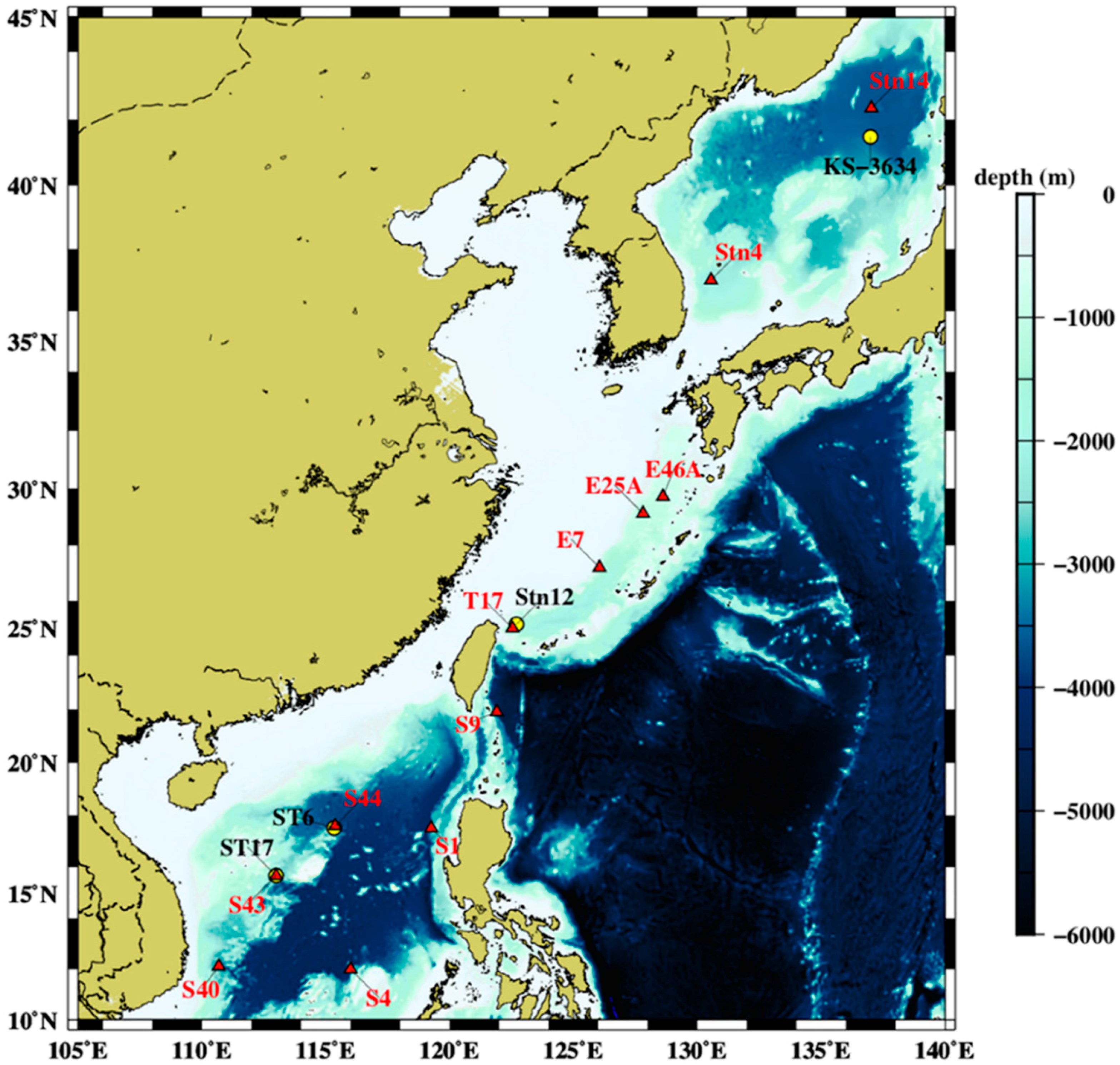

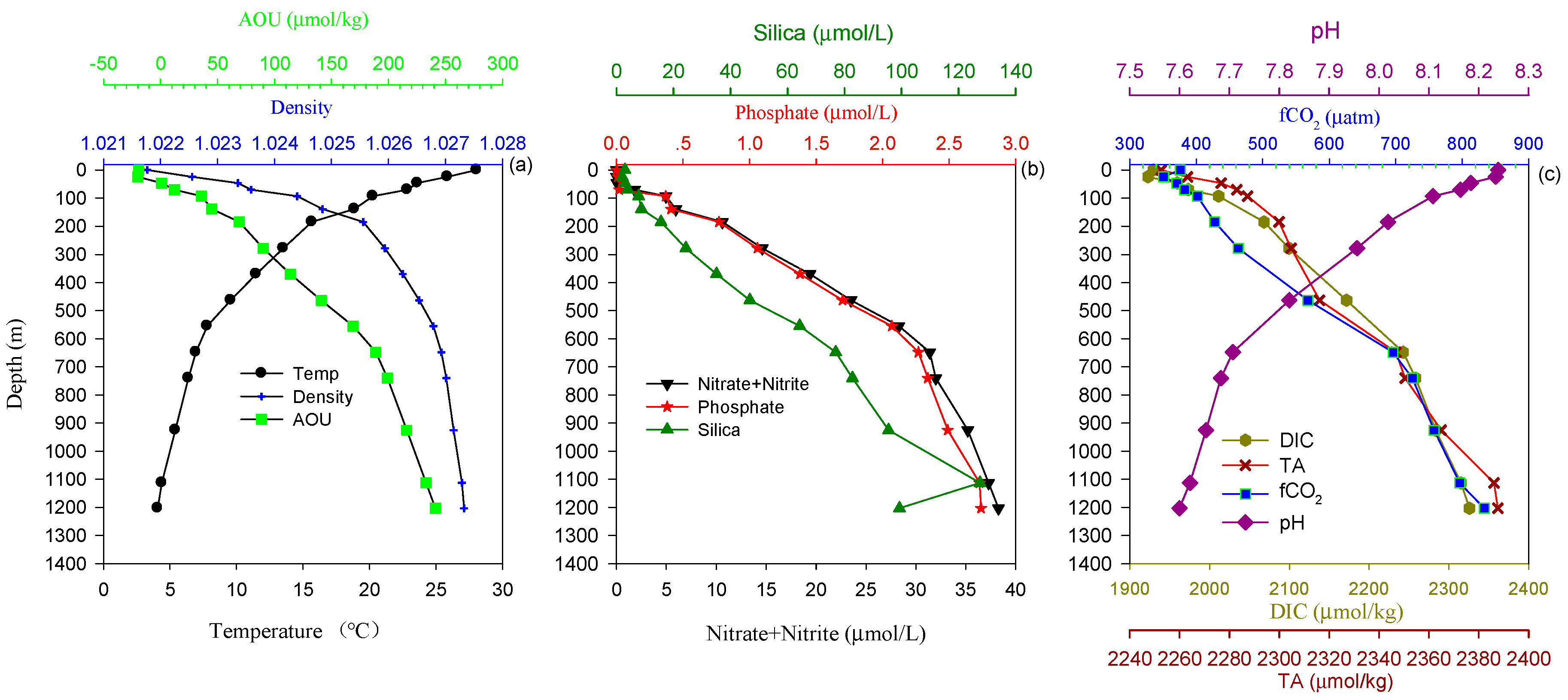
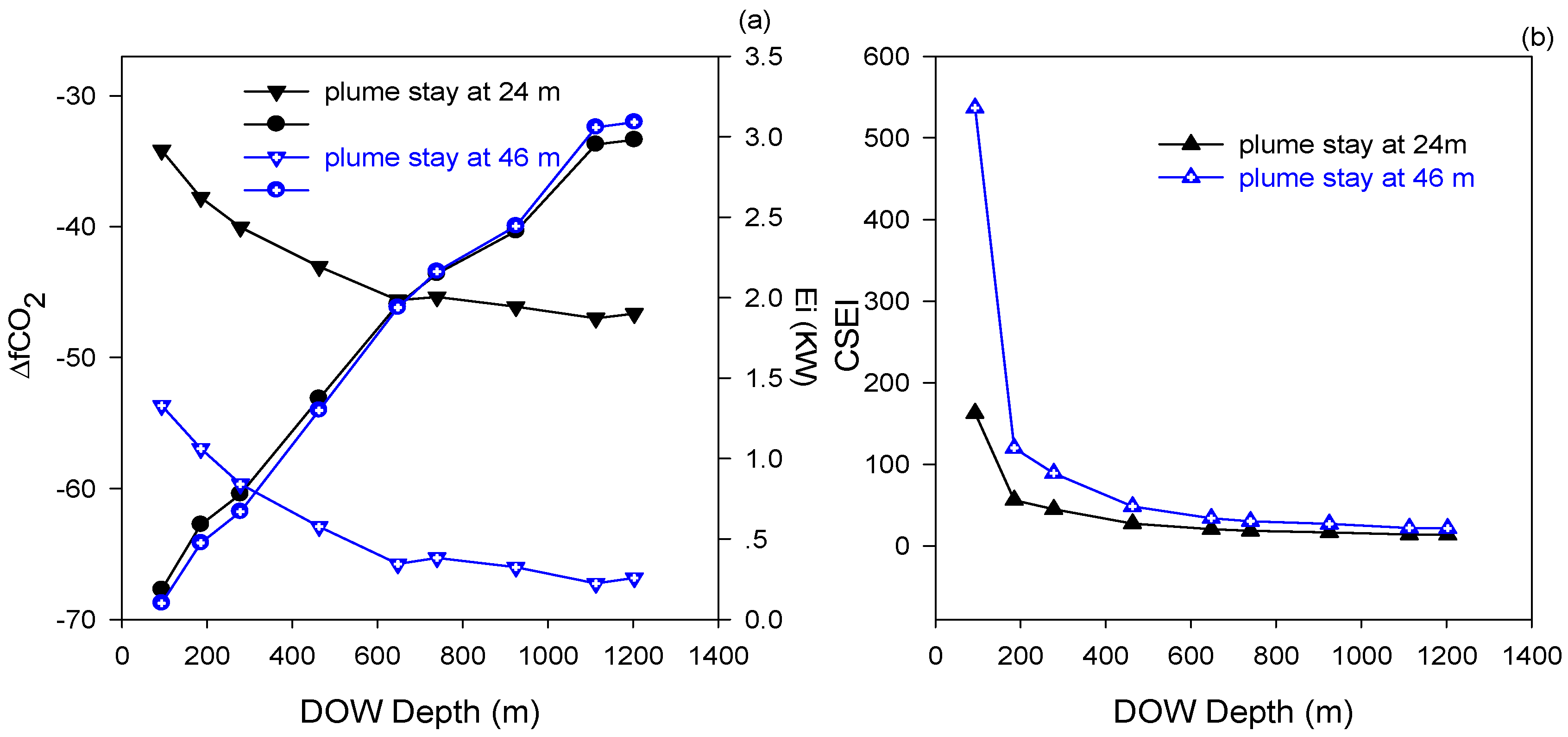
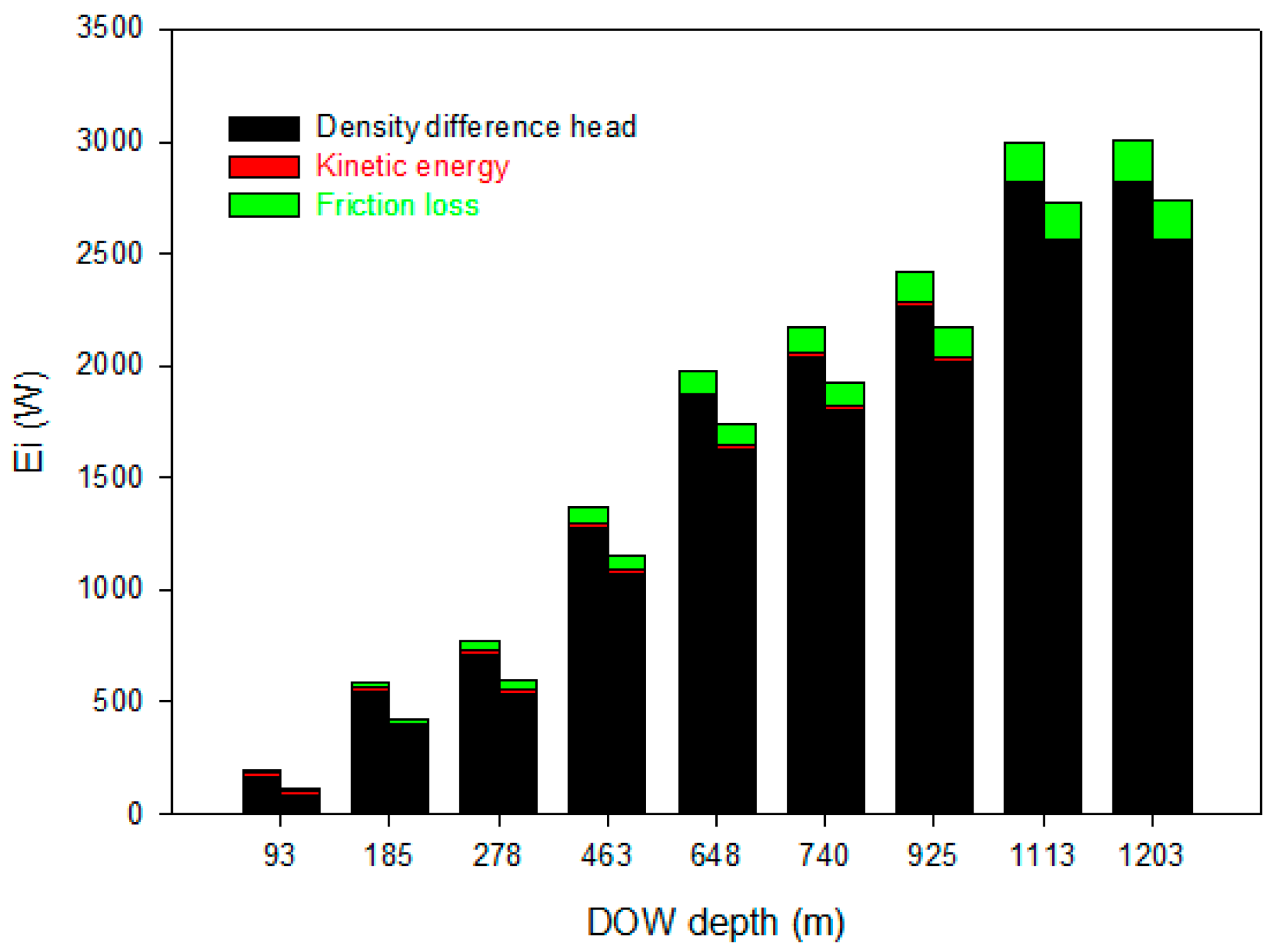
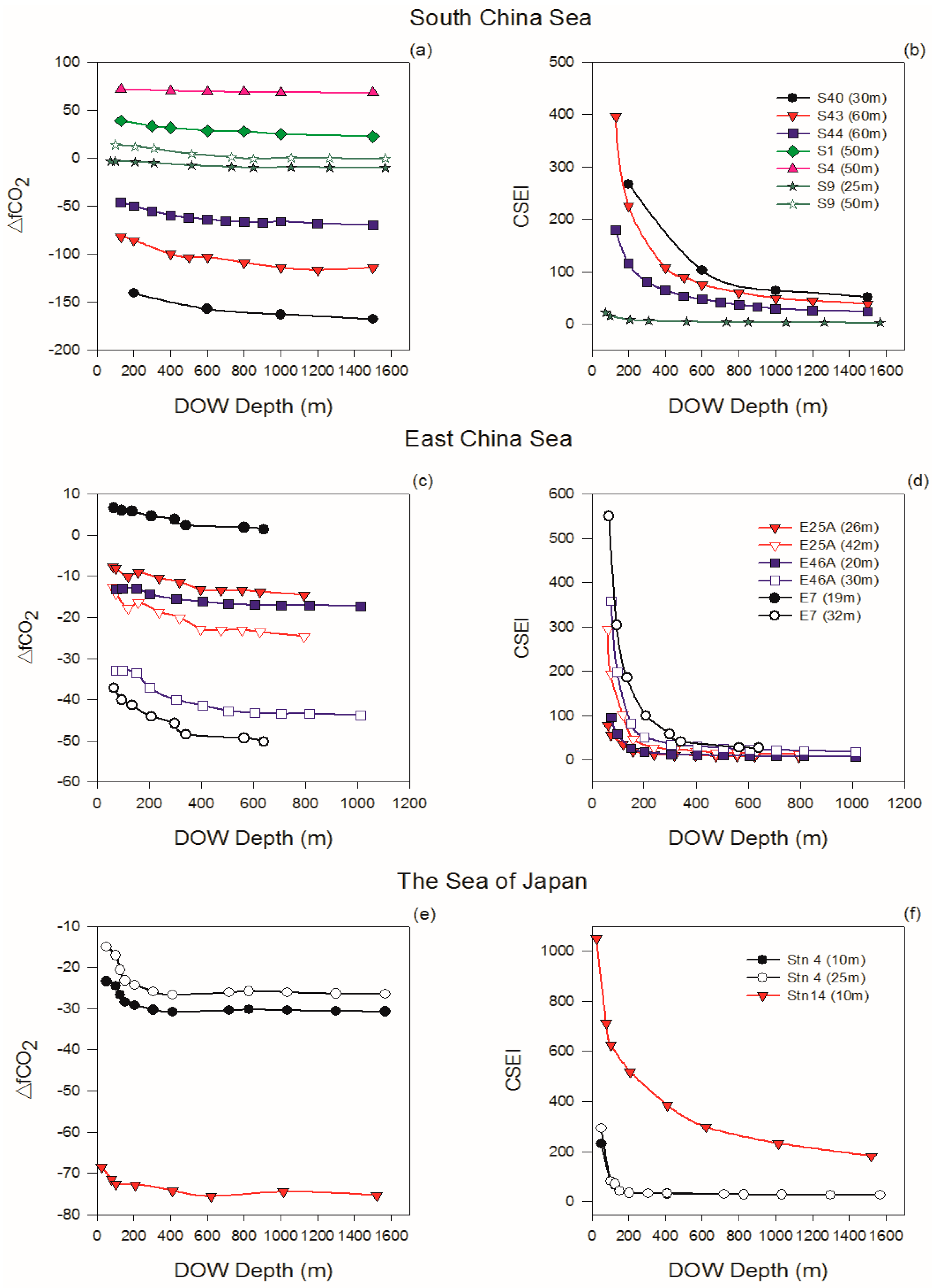

| T17 | (kg/m3) | (m) | (m) | (%) | L (m) | (W) | (W) | (W) | (W) | ||
|---|---|---|---|---|---|---|---|---|---|---|---|
| Case1-1 | 1024.4 | 93 | 24 | 14.3 | 316.4 | −34.17 | 69 | 210 | 168 | 24 | 18 |
| 1-2 | 1025.6 | 185 | 18 | 9.1 | 312.8 | −37.79 | 167 | 672 | 594 | 60 | 18 |
| 1-3 | 1025.9 | 278 | 17 | 8.3 | 310.5 | −40.05 | 261 | 889 | 778 | 93 | 18 |
| 1-4 | 1026.5 | 463 | 14 | 7.1 | 307.5 | −43.05 | 449 | 1568 | 1390 | 160 | 18 |
| 1-5 | 1026.9 | 648 | 13 | 6.5 | 305.0 | −45.61 | 635 | 2237 | 1992 | 227 | 18 |
| 1-6 | 1027.0 | 740 | 13 | 6.4 | 305.2 | −45.38 | 727 | 2455 | 2177 | 260 | 18 |
| 1-7 | 1027.1 | 925 | 12 | 6.3 | 304.4 | −46.12 | 913 | 2758 | 2414 | 326 | 18 |
| 1-8 | 1027.3 | 1113 | 12 | 6.0 | 303.6 | −47.00 | 1101 | 3374 | 2962 | 394 | 18 |
| 1-9 | 1027.3 | 1203 | 12 | 6.0 | 303.91 | −46.66 | 1191 | 3406 | 2962 | 426 | 18 |
| Case2-1 | 1024.4 | 93 | 52 | 23.1 | 317.0 | −53.67 | 41 | 100 | 68 | 14 | 18 |
| 2-2 | 1025.6 | 185 | 43 | 12.0 | 313.7 | −56.96 | 142 | 475 | 406 | 51 | 18 |
| 2-3 | 1025.9 | 278 | 42 | 10.7 | 311.0 | −59.67 | 236 | 669 | 567 | 84 | 18 |
| 2-4 | 1026.5 | 463 | 39 | 8.8 | 307.7 | −62.91 | 424 | 1300 | 1131 | 151 | 18 |
| 2-5 | 1026.9 | 648 | 38 | 7.9 | 304.9 | −65.77 | 610 | 1939 | 1703 | 218 | 18 |
| 2-6 | 1027.0 | 740 | 37 | 7.7 | 305.3 | −65.30 | 703 | 2162 | 1893 | 251 | 18 |
| 2-7 | 1027.1 | 925 | 37 | 7.5 | 304.6 | −66.02 | 888 | 2444 | 2109 | 317 | 18 |
| 2-8 | 1027.3 | 1113 | 36 | 7.2 | 303.4 | −67.26 | 1077 | 3058 | 2655 | 385 | 18 |
| 2-9 | 1027.3 | 1203 | 36 | 7.2 | 303.81 | −66.83 | 1167 | 3090 | 2655 | 417 | 18 |
© 2018 by the authors. Licensee MDPI, Basel, Switzerland. This article is an open access article distributed under the terms and conditions of the Creative Commons Attribution (CC BY) license (http://creativecommons.org/licenses/by/4.0/).
Share and Cite
Pan, Y.; You, L.; Li, Y.; Fan, W.; Chen, C.-T.A.; Wang, B.-J.; Chen, Y. Achieving Highly Efficient Atmospheric CO2 Uptake by Artificial Upwelling. Sustainability 2018, 10, 664. https://doi.org/10.3390/su10030664
Pan Y, You L, Li Y, Fan W, Chen C-TA, Wang B-J, Chen Y. Achieving Highly Efficient Atmospheric CO2 Uptake by Artificial Upwelling. Sustainability. 2018; 10(3):664. https://doi.org/10.3390/su10030664
Chicago/Turabian StylePan, Yiwen, Long You, Yifan Li, Wei Fan, Chen-Tung Arthur Chen, Bing-Jye Wang, and Ying Chen. 2018. "Achieving Highly Efficient Atmospheric CO2 Uptake by Artificial Upwelling" Sustainability 10, no. 3: 664. https://doi.org/10.3390/su10030664




